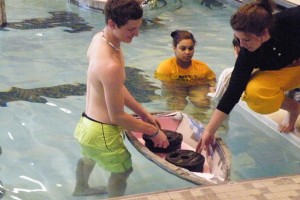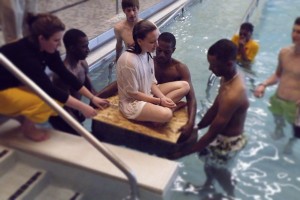The students in Mr. Stout’s junior engineering class stood in their swimsuits at North Point’s pool on Thursday, April 16. They had not come for a swim, but had come to decide whose boat would float best.
After one week of boat building, the class of 25 engineering students took their concrete boats out to the pool to test them for buoyancy; an upward acting force caused by fluid pressure, that keeps things afloat.
“We made Styrofoam molds of our boats and covered it in concrete solution, then carved out the inside,” described junior Ben Snellings (’11). But constructing the boat wasn’t the hard part; testing it was.

Floating along the shallow end, boats came in various shapes and sizes. “Buoyancy is about volume of the boat,” explained Snellings whose boat weighed 60 pounds and was expected to hold up to 200 pounds.
Students placed weights on their boat slowly but carefully. Kaylah Bovard (’11), Nick Cooper (’11), and Jamal Butler’s (’11) boat was among the first to be tested, weighing 67 pounds and holding up to 75 pounds. Ben Walsh (’11), Jane Wilson (’11), and James Truckle’s (’11) boat weighed 20 pounds and was able to hold 55 pounds.
Some boats were able to withstand the weight, while others sunk. “We had to disperse the weight unevenly for it work,” explained Jarel Chisholm (’11), whose boat weighed 20 pounds but could only hold up to 40 pounds. “If our boat was level, it would have been able to hold up more weight.”

Other boats, however, were able to hold up more weight than expected. Kricket Kline (’11) boarded Harold Hayes (’11), Xavier Hollins (’11), and Stephen Martin’s (’11) boat. It weighed only 56 pounds but ended up holding a whopping 210 pounds.
The amount of weight the boats were able to hold up varied between groups. Many factors affected the amount of weight the boats were able to hold, including boat shape. “We wanted to have a base shape,” Hayes explained their well designed craft. In order for it to work, he had to calculate its weight, central center of gravity, how deep it would go into the water, and it’s buoyancy.
However, it was not just buoyancy that would determine how well the boat would float. As Shawn Cannon (’11) pulled on his scuba mask, he used air bubbles to simulate methane gas bubbles- which are known to sink ships at sea.
Students from the Carpentry and Construction classes were invited to watch. “It was interesting to see these heavy concrete boats just floating on the water,” commented junior, Rennel Romero.




